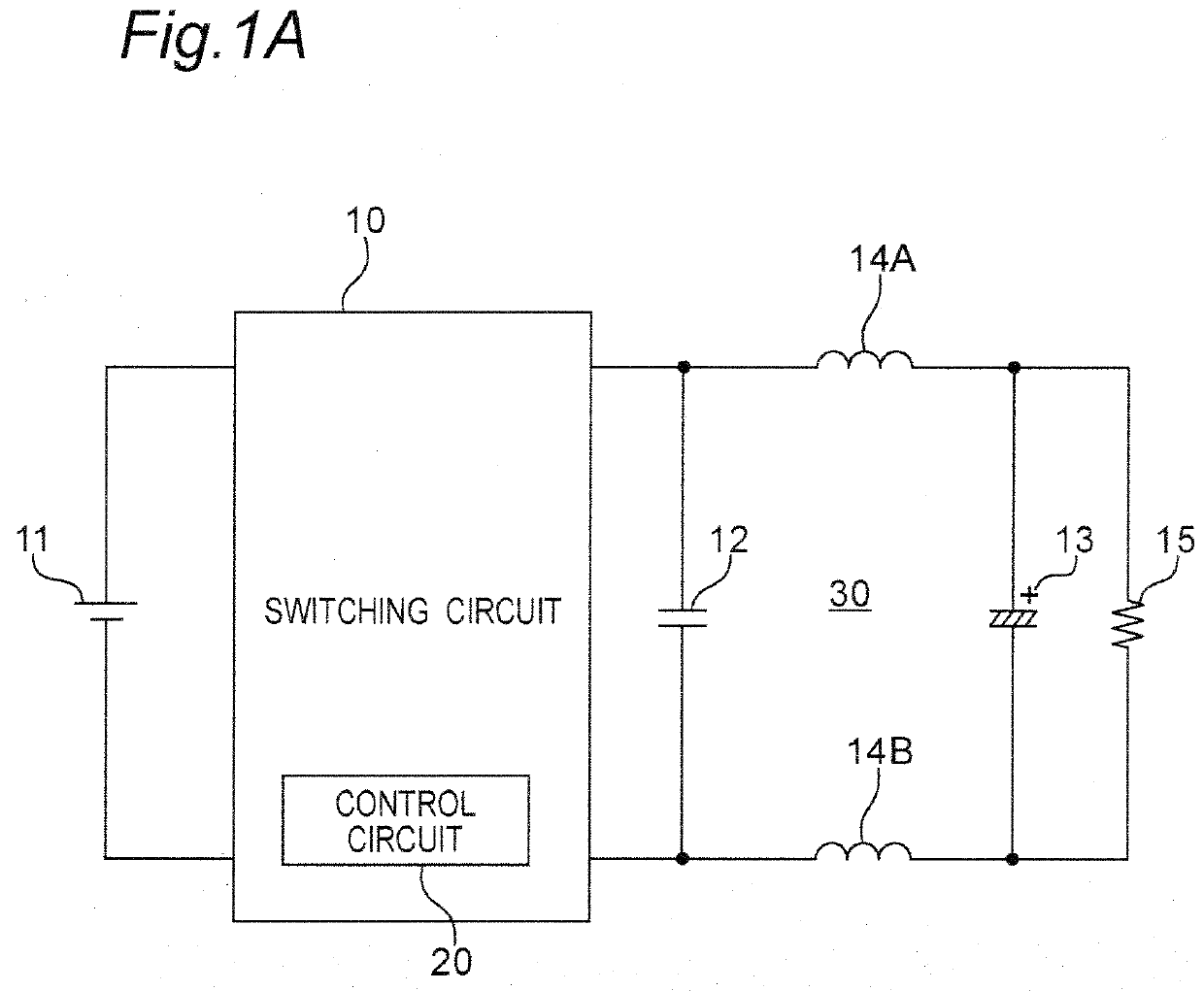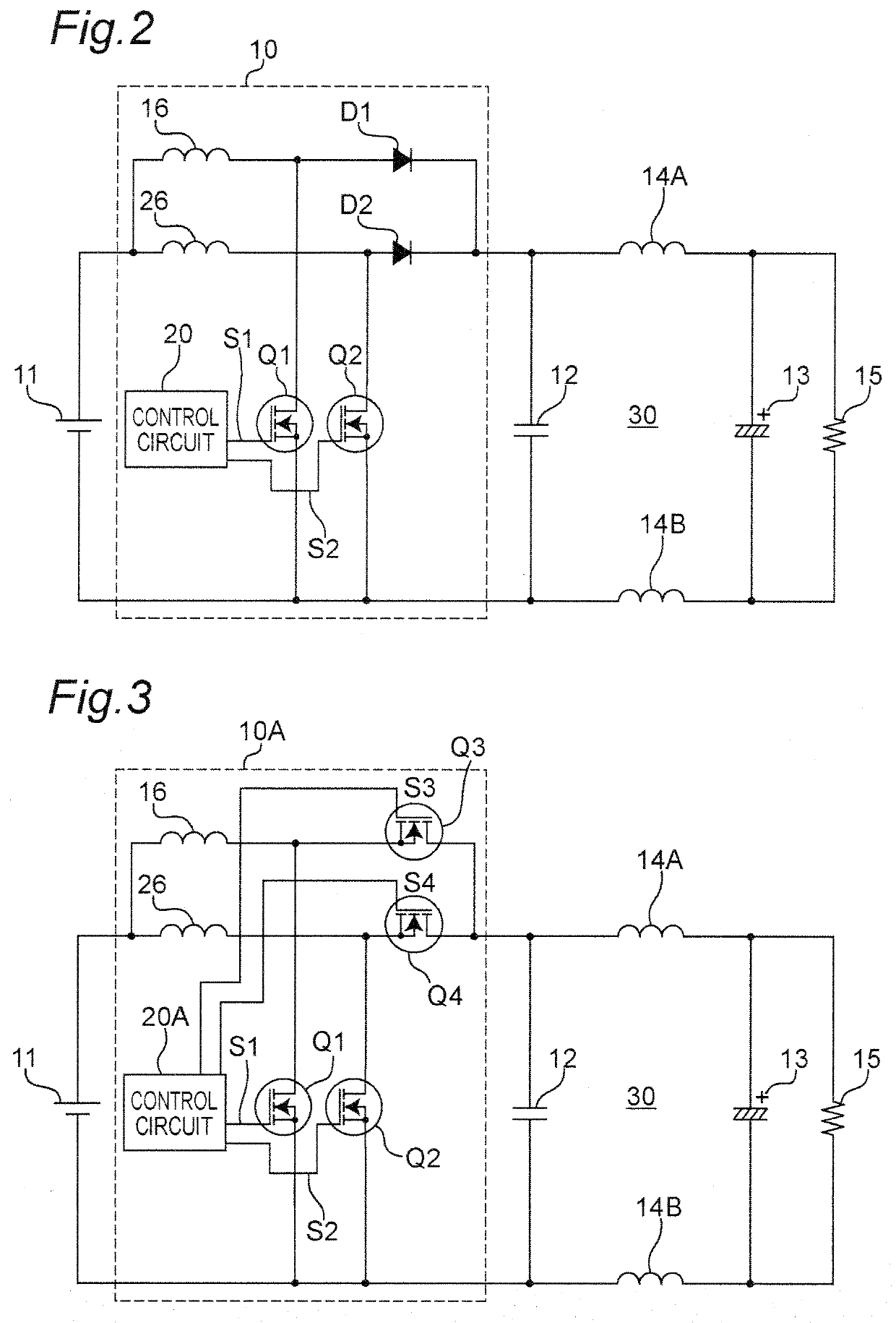Power converter apparatus provided with low-pass filter circuit for reducing switching frequency components
- Summary
- Abstract
- Description
- Claims
- Application Information
AI Technical Summary
Benefits of technology
Problems solved by technology
Method used
Image
Examples
first embodiment
[0028]FIG. 1A is a circuit diagram illustrating a configuration example of a power converter apparatus according to a first embodiment. Referring to FIG. 1A, the power converter apparatus according to the first embodiment is inserted between a direct current (DC) voltage source 11 and a load 15. The power converter apparatus includes a switching circuit 10 and a filter circuit 30. The switching circuit 10 generates an alternating current (AC) voltage by switching the DC voltage from the DC voltage source 11 at a predetermined switching frequency (fSW), and outputs the AC voltage to the filter circuit 30. Next, the filter circuit 30 low-pass filters the AC voltage from the switching circuit to convert the AC voltage into a DC voltage, and outputs the DC voltage to the load 15.
[0029]The switching circuit 10 includes a switching device that switches the DC voltage, and a control circuit 20 that generates a drive signal for driving the switching device with on / off control in a predeterm...
modified embodiment of first embodiment
[0036]FIG. 1B is a circuit diagram illustrating a configuration example of a power converter apparatus according to the modified embodiment of the first embodiment. The power converter apparatus of FIG. 1B differs from the power converter apparatus of FIG. 1A in the following point.
[0037](1) Instead of one switching circuit 10, a plurality of M number of switching circuits 10-1 to 10-M is included. Each of the switching circuits 10-1 to 10-M may separately include each of control circuits 20-1 to 20-M that generate a drive signal for driving a switching device, or one control circuit may drive each switching device of a plurality of switching circuits 10-1 to 10-M.
[0038]The power converter apparatus according to the modified embodiment of the first embodiment configured as described above has an action and advantageous effects similar to those of the power converter apparatus according to the first embodiment.
second embodiment
[0039]FIG. 2 is a circuit diagram illustrating a configuration example of an asynchronous power converter apparatus having a step-up function according to a second embodiment. The power converter apparatus according to the second embodiment illustrates a circuit configuration of a switching circuit 10 in detail as compared with the power converter apparatus of FIG. 1, and only differences will be described below.
[0040]Referring to FIG. 2, the switching circuit 10 includes a step-up reactor 16, a switching device Q1 constituted of, for example, a MOSFET, an IGBT, or the like, a diode D1, and a control circuit 20. The DC voltage from the DC voltage source 11 is applied to both of the ends of the drain and source of the switching device Q1 via a reactor 16, and the drain of the switching device Q1 is connected to one end of a bypass capacitor 12 via the diode D1. The control circuit 20 generates a drive signal S1 for driving the switching device Q1 with on / off control in a predetermine...
PUM
 Login to View More
Login to View More Abstract
Description
Claims
Application Information
 Login to View More
Login to View More - R&D
- Intellectual Property
- Life Sciences
- Materials
- Tech Scout
- Unparalleled Data Quality
- Higher Quality Content
- 60% Fewer Hallucinations
Browse by: Latest US Patents, China's latest patents, Technical Efficacy Thesaurus, Application Domain, Technology Topic, Popular Technical Reports.
© 2025 PatSnap. All rights reserved.Legal|Privacy policy|Modern Slavery Act Transparency Statement|Sitemap|About US| Contact US: help@patsnap.com



